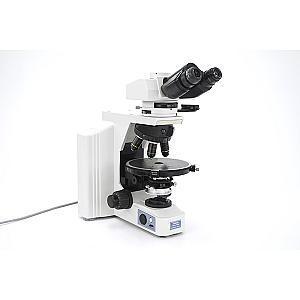The Nikon Eclipse E600 microscope is a mid-range research instrument equipped with the revolutionary CFI60 infinite optical system. It delivers bright, sharp and clear images in all applications. Ideal for laboratories and medical institutions, it is known for its versatility and reliability. The CFI60 optical system allows for a longer working distance and a larger numerical aperture, ensuring high resolution for brilliantly sharp images.
Eclipse E600 Microscope - Good Condition





Offer Details
Accessories :
Nikon E600 POL Polarizing Light Microscope Polarisationsmikroskop
Options :
8471
Description
Nikon Eclipse E600 Research Microscope: Versatility and Performance for Laboratories
The Nikon Eclipse E600 microscope is a mid-range instrument designed for laboratory research applications. Introduced in the 1990s, this microscope features a CFI60 infinity optical system that delivers exceptionally clear and sharp images. This optical system delivers bright, high-contrast images regardless of the application, making it a preferred choice for research laboratories and medical institutions.
The Nikon Eclipse E600 is equipped with a 12-volt , 100-watt halogen lamp , providing stable and reliable illumination. It also features a filter magazine and a removable stage, allowing for great flexibility in experiment setup. The microscope has a 25-degree inclined eyepiece tube, promoting an ergonomic posture for the user. For taller users, an optional riser allows the height of the eyepieces to be adjusted up to 100 millimetres.
The Eclipse E600 is compatible with a variety of objectives, including universal objectives that allow multiple observation techniques without changing objectives. This includes techniques such as phase contrast, bright field, dark field, Nomarski differential interference contrast (DIC) and epifluorescence. This versatility allows researchers to perform a wide range of analyses with a single instrument, optimising laboratory efficiency and productivity.
The ergonomic design of the Eclipse E600 is designed to reduce user fatigue. The fine focus and stage movement controls are positioned for easy access, allowing precise adjustments without excessive effort. This attention to ergonomics allows for extended observation sessions without discomfort, which is crucial for intensive research work.
In terms of technical specifications, the Nikon Eclipse E600 has a parfocal distance of 60 millimetres, a thread diameter of 25 millimetres and a standard field of view of 22 millimetres. These technical features allow for extensive compatibility with various accessories and additional modules, such as microphotography and digital imaging systems.
Features
- CFI60 infinite optical system for clear, sharp images.
- Compatibility with various observation techniques: phase contrast, bright field, dark field, DIC, epifluorescence.
- Ergonomic design for prolonged use without fatigue.
- Removable stage and filter magazine for increased flexibility.
- Compatible with additional accessories for microphotography and digital imaging.
- 12V/100W halogen lamp for stable illumination.
- Optional riser to adjust the height of the eyepieces.
- Innovative focusing system for one-handed control.
- Comfortable head and eye positioning thanks to the angle of the eyepiece tube.
- Reduced stage height for easier sample handling.
- Computer-aided design (CAE) for increased rigidity and vibration resistance.
- Automatic photo preset switch for simplified use in photomicrography.
- Epifluorescence filters for simplified fluorescence observations.
- Plan Fluor objectives for high UV transmission and superior image flatness.
- Front shutter for easy access in dimly lit rooms.
- Wide range of filter options for various applications.
Technical Details
- Weight: 15 kg (approx., depending on configuration)
- Dimensions: 380 mm (W) x 420 mm (D) x 290 mm (H)
- Light source: 12V/100W halogen lamp
- Parfocal distance: 60 mm
- Thread diameter: 25 mm
- Field of view: 22 mm
- Eyepiece tube tilt: 25 degrees
- Lens compatibility: Universal lenses for various observation techniques
- Objectives: CFI60 (infinite optical system)
- Eyepiece tubes: Binocular, trinocular types F and T, ergonomic
- Eyepieces: 10X (field of view 22 mm), 10X M photo mask (field of view 22 mm), 12.5X (field of view 16 mm), 15X (field of view 14.5 mm), UW 10X (field of view 25 mm)
- Photo lenses: PLI projection lenses: 2X, 2.5X, 4X, 5X
- Objective lens turret: Sextuple, Sextuple DIC (with analyser slot)
- Focus: Fine: 0.1 mm per rotation, Coarse: 12.7 mm per rotation, Minimum reading: 1 micron on left knob, Adjustable coarse movement tension, Built-in focus lock
- Stage: Super hard surface, rectangular stage 160.5 mm x 208.5 mm, cross travel range 78 mm x 54 mm
- Substage: Removable (can be moved 15 mm down), Vertical movement: 25 mm
- Illumination: 12V 100W halogen lamp, pre-centred and pre-focused, automatic photo preset switch
- Filters: Integrated filter magazine (ND8, ND32, NCB11), Up to 2 optional filters (diameter 45 mm) mountable on the field lens unit, Integrated diffuser, can be removed from the optical axis with a tool
Compatible Accessories
- Microphotography and digital imaging systems.
- Additional filters for various observation applications.
- Specialised objectives for specific observation techniques.
- Adapters for digital cameras.
- Epifluorescence illumination modules.
- Teaching heads for simultaneous observation by multiple people.
- Dual port for simultaneous use of two CCTV camera systems.
- Drawing tube for ultra-wide field observations.